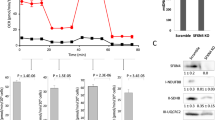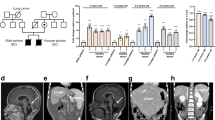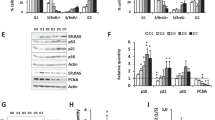Abstract
The cause of the molecular defect of Fanconi anemia (FA) remains unknown. Cells from patients with FA exert an elevated spontaneous chromosomal instability which is further triggered by mitomycin C. The induced lability is reduced by overexpression of thioredoxin which is not the case for spontaneous instability. However, both are eliminated by overexpression of thioredoxin cDNA with an added nuclear localization signal. This implies that thioredoxin is lacking in the nuclei of FA cells. The total thioredoxin content in all FA cells tested is reduced. The resultant lack of nuclear thioredoxin can be the explanation for the major symptomatology in FA. Since thioredoxin is known to be the reactive cofactor of ribonucleotid reductase its shortcoming reduces the supply of deoxyribonucleotides thus hindering the DNA and replication repair with resultant chromosomal breaks. Furthermore, depression of tyrosine hydroxylase, the key enzyme of melanine synthesis, could be the basis for the pathognomotic ‘café au lait’ spots of FA. The observation of thioredoxin reduction in FA cells permits insight into the molecular phathophysiology of FA.
This is a preview of subscription content, access via your institution
Access options
Subscribe to this journal
Receive 50 print issues and online access
$259.00 per year
only $5.18 per issue
Buy this article
- Purchase on Springer Link
- Instant access to full article PDF
Prices may be subject to local taxes which are calculated during checkout







Similar content being viewed by others
References
Alter BP . 1993 Br. J. Haematol. 85: 9–14
Cumming RC, Lightfoot J, Beard K, Youssoufian H, O'Brien PJ, Buchwald M . 2001 Nat. Med. 7: 814–820
Dallapiccola B, Porfirio B, Mokini V, Alimena G, Isacchi G, Gandini E . 1985 Hum. Genet. 69: 62–65
Fanconi G . 1927 Jahrb Kinderheilkd. 117: 257–280
Fujii S, Nanbu Y, Konishi I, Mori T, Masutani H, Yodoi J . 1991 Virchows. Arch. Pathol. Anat. Histopathol. 419: 317–326
Garcia-Higuera I, Taniguchi T, Ganesan S, Meyn MS, Timmers C, Hejna J, Grompe M, D'Andrea AD . 2001 Mol. Cell 7: 249–262
Gille JJP, Wortelboer HM, Joenje H . 1987 Hum. Genet. 77: 28–31
Hirota K, Murata U, Sachi Y, Nakamura H, Takeuchi J, Mori K, Yodoi J . 1999 J. Biol. Chem. 274: 27891–27897
Holmgren A . 1985 Annu. Rev. Biochem. 54: 237–271
Izawa S, Maeda K, Sugiyama K, Mano J, Inoue Y, Kimura A . 1999 J. Biol. Chem. 274: 28459–28465
Joenje H, Arwert F, Eriksson AW, de Koning H, Oostra AB . 1981 Nature 290: 140–143
Korkina LG, Samochatova EV, Maschan AA, Suslova TB, Cheremisina ZP, Afanasev IB . 1992 J. Leukocyte Biol. 52: 357–362
Matsui M, Oshima M, Oshima H, Takaku K, Maruyama T, Yodoi J, Taketo MM . 1996 Dev. Biol. 178: 179–185
Oliviera L, Bouton C, Drapier JC . 1999 J. Biol. Chem. 274: 516–521
Ramirez MH, Ruppitsch W, Hirsch-Kauffmann M, Schweiger M . 1999 Biochem. Biophys. Res. Commun. 264: 518–524
Rubartelli A, Bajetto A, Allavena G, Wollman E, Sitia R . 1992 J. Biol. Chem. 267: 24161–24164
Rubartelli A, Bonifaci N, Sitia R . 1995 Cancer Res. 55: 675–680
Ruppitsch W, Meißlitzer C, Hirsch-Kauffmann M, Schweiger M . 1998 FEBS Lett. 422: 99–102
Ruppitsch W, Meißlitzer C, Weirich-Schwaiger H, Klocker H, Scheidereit C, Schweiger M, Hirsch-Kauffmann M . 1997 Hum. Genet. 99: 710–719
Sambrook J, Fritsch FF, Maniatis T . 1989 Molecular Cloning: A laboratory manual Nolan, C. (ed) Cold Spring Harbor Laboratory Press, N.Y pp 712–715
Schenk H, Klein M, Erdbrügger W, Dröge W, Schulze-Osthoff K . 1994 Proc. Natl. Acad. Sci. USA 91: 1672–1676
Schindler D, Hoehn H . 1988 Am. J. Hum. Genet. 43: 429–435
Schreiber E, Matthias P, Müller MM, Schaffner W . 1989 Nucleic Acid Res. 15: 6419–
Sen CK, Packer L . 1996 FASEB J. 10: 709–720
Sittler A, Davys D, Weber C, Mandel JL . 1996 Human Mol. Genet. 1: 95–102
Wood JM, Schallreuter KU . 1991 Biochim. Biophys. Acta 1074: 378–385
Acknowledgements
We acknowledge with thanks Klaus Hennig for the overexpression and isolation of thioredoxin and Dr Rossi for raising antithioredoxin antibodies. We are very grateful to Prof Dr D Hirsch-Kauffmann Jokl, New York for editing suggestions. This work was possible through the generous support by grants from Thyssen-foundation (20002084).
Author information
Authors and Affiliations
Corresponding author
Rights and permissions
About this article
Cite this article
Kontou, M., Adelfalk, C., Ramirez, M. et al. Overexpressed thioredoxin compensates Fanconi anemia related chromosomal instability. Oncogene 21, 2406–2412 (2002). https://doi.org/10.1038/sj.onc.1205299
Received:
Revised:
Accepted:
Published:
Issue Date:
DOI: https://doi.org/10.1038/sj.onc.1205299
Keywords
This article is cited by
-
Thioredoxin, a regulator of gene expression
Oncogene (2004)



